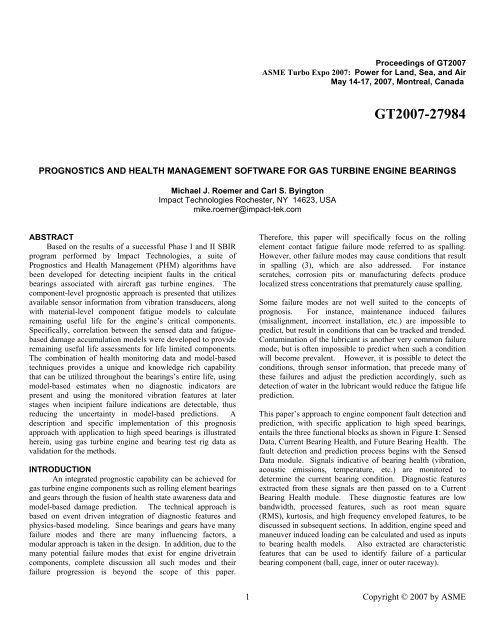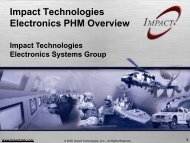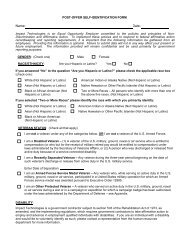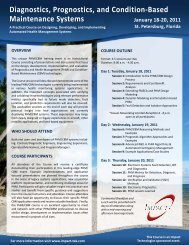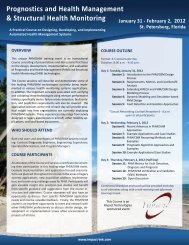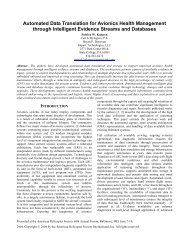prognostics and health management software for gas turbine
prognostics and health management software for gas turbine
prognostics and health management software for gas turbine
Create successful ePaper yourself
Turn your PDF publications into a flip-book with our unique Google optimized e-Paper software.
Proceedings of GT2007<br />
ASME Turbo Expo 2007: Power <strong>for</strong> L<strong>and</strong>, Sea, <strong>and</strong> Air<br />
May 14-17, 2007, Montreal, Canada<br />
GT2007-27984<br />
PROGNOSTICS AND HEALTH MANAGEMENT SOFTWARE FOR GAS TURBINE ENGINE BEARINGS<br />
Michael J. Roemer <strong>and</strong> Carl S. Byington<br />
Impact Technologies Rochester, NY 14623, USA<br />
mike.roemer@impact-tek.com<br />
ABSTRACT<br />
Based on the results of a successful Phase I <strong>and</strong> II SBIR<br />
program per<strong>for</strong>med by Impact Technologies, a suite of<br />
Prognostics <strong>and</strong> Health Management (PHM) algorithms have<br />
been developed <strong>for</strong> detecting incipient faults in the critical<br />
bearings associated with aircraft <strong>gas</strong> <strong>turbine</strong> engines. The<br />
component-level prognostic approach is presented that utilizes<br />
available sensor in<strong>for</strong>mation from vibration transducers, along<br />
with material-level component fatigue models to calculate<br />
remaining useful life <strong>for</strong> the engine’s critical components.<br />
Specifically, correlation between the sensed data <strong>and</strong> fatiguebased<br />
damage accumulation models were developed to provide<br />
remaining useful life assessments <strong>for</strong> life limited components.<br />
The combination of <strong>health</strong> monitoring data <strong>and</strong> model-based<br />
techniques provides a unique <strong>and</strong> knowledge rich capability<br />
that can be utilized throughout the bearings’s entire life, using<br />
model-based estimates when no diagnostic indicators are<br />
present <strong>and</strong> using the monitored vibration features at later<br />
stages when incipient failure indications are detectable, thus<br />
reducing the uncertainty in model-based predictions. A<br />
description <strong>and</strong> specific implementation of this prognosis<br />
approach with application to high speed bearings is illustrated<br />
herein, using <strong>gas</strong> <strong>turbine</strong> engine <strong>and</strong> bearing test rig data as<br />
validation <strong>for</strong> the methods.<br />
INTRODUCTION<br />
An integrated prognostic capability can be achieved <strong>for</strong><br />
<strong>gas</strong> <strong>turbine</strong> engine components such as rolling element bearings<br />
<strong>and</strong> gears through the fusion of <strong>health</strong> state awareness data <strong>and</strong><br />
model-based damage prediction. The technical approach is<br />
based on event driven integration of diagnostic features <strong>and</strong><br />
physics-based modeling. Since bearings <strong>and</strong> gears have many<br />
failure modes <strong>and</strong> there are many influencing factors, a<br />
modular approach is taken in the design. In addition, due to the<br />
many potential failure modes that exist <strong>for</strong> engine drivetrain<br />
components, complete discussion all such modes <strong>and</strong> their<br />
failure progression is beyond the scope of this paper.<br />
There<strong>for</strong>e, this paper will specifically focus on the rolling<br />
element contact fatigue failure mode referred to as spalling.<br />
However, other failure modes may cause conditions that result<br />
in spalling (3), which are also addressed. For instance<br />
scratches, corrosion pits or manufacturing defects produce<br />
localized stress concentrations that prematurely cause spalling.<br />
Some failure modes are not well suited to the concepts of<br />
prognosis. For instance, maintenance induced failures<br />
(misalignment, incorrect installation, etc.) are impossible to<br />
predict, but result in conditions that can be tracked <strong>and</strong> trended.<br />
Contamination of the lubricant is another very common failure<br />
mode, but is often impossible to predict when such a condition<br />
will become prevalent. However, it is possible to detect the<br />
conditions, through sensor in<strong>for</strong>mation, that precede many of<br />
these failures <strong>and</strong> adjust the prediction accordingly, such as<br />
detection of water in the lubricant would reduce the fatigue life<br />
prediction.<br />
This paper’s approach to engine component fault detection <strong>and</strong><br />
prediction, with specific application to high speed bearings,<br />
entails the three functional blocks as shown in Figure 1: Sensed<br />
Data, Current Bearing Health, <strong>and</strong> Future Bearing Health. The<br />
fault detection <strong>and</strong> prediction process begins with the Sensed<br />
Data module. Signals indicative of bearing <strong>health</strong> (vibration,<br />
acoustic emissions, temperature, etc.) are monitored to<br />
determine the current bearing condition. Diagnostic features<br />
extracted from these signals are then passed on to a Current<br />
Bearing Health module. These diagnostic features are low<br />
b<strong>and</strong>width, processed features, such as root mean square<br />
(RMS), kurtosis, <strong>and</strong> high frequency enveloped features, to be<br />
discussed in subsequent sections. In addition, engine speed <strong>and</strong><br />
maneuver induced loading can be calculated <strong>and</strong> used as inputs<br />
to bearing <strong>health</strong> models. Also extracted are characteristic<br />
features that can be used to identify failure of a particular<br />
bearing component (ball, cage, inner or outer raceway).<br />
1 Copyright © 2007 by ASME
•Engine speed<br />
•Maneuvers<br />
•Vibration<br />
•Oil pressure<br />
•Oil temperature<br />
•Oil quality<br />
Mission<br />
Profile<br />
Sensed Data<br />
Future Bearing Health<br />
Spall Initiation Model<br />
x<br />
+<br />
y<br />
+<br />
z<br />
3<br />
⎛<br />
Q<br />
c<br />
⎞<br />
L<br />
=<br />
⎜<br />
⎟<br />
⎝<br />
Q<br />
⎠<br />
Yu-Harris<br />
No<br />
Current Bearing Health<br />
Spall Initiation Model<br />
⎛<br />
Q<br />
⎞<br />
L<br />
⎝<br />
Q<br />
⎠<br />
x<br />
+<br />
y<br />
+<br />
z<br />
3<br />
c<br />
= ⎜<br />
⎟<br />
Yu-Harris<br />
Spall?<br />
Fusion<br />
engine rotors, blade passing, <strong>and</strong> gear mesh in a running<br />
engine. This difficulty is illustrated in Figure 2.<br />
RUL<br />
Progression Model<br />
⎛<br />
⎛ 1<br />
⎞<br />
e<br />
c<br />
⎜<br />
⎟<br />
∝<br />
N<br />
⎜<br />
∫ τ<br />
d<br />
v<br />
ln<br />
⎝<br />
S<br />
⎠<br />
⎝<br />
e<br />
⎞<br />
v ⎟<br />
⎠<br />
Yes<br />
Figure 1. Overall Bearing Prognostic Architecture<br />
Central to the Current Bearing Health step is a material-level,<br />
rolling contact fatigue (RCF) model. This model utilizes<br />
in<strong>for</strong>mation from the Sensed Data module to calculate the<br />
cumulative damage sustained by the bearing since it was first<br />
installed. Life limiting parameters used by the RCF model<br />
such as load <strong>and</strong> lubricant film thickness are derived from the<br />
sensed data using physics-based <strong>and</strong> empirical models.<br />
Utilizing an in<strong>for</strong>mation fusion process, this probability is<br />
combined with the extracted features that are indicative of<br />
spalling. Combining the model output with the features<br />
improves the robustness <strong>and</strong> accuracy of the prediction.<br />
Whether or not a spall is detected determines the next step of<br />
estimating Future Bearing Health. If a spall does not currently<br />
exist the spall initiation prognostic module is used to <strong>for</strong>ecast<br />
the time to spall initiation. This <strong>for</strong>ecast is based on the same<br />
model that is used to assess the current probability of spall<br />
initiation, but instead the model uses projected future operating<br />
conditions (loads, speeds, etc.) rather than the current<br />
conditions. Then the initiation results are passed to the<br />
progression model, which also uses the mission profile to allow<br />
an accurate prediction on the time from spall initiation to<br />
failure. If a spall currently exists, the spall initiation prognostic<br />
module is bypassed <strong>and</strong> only the spall progression model is<br />
used.<br />
HIGH FREQUENCY VIBRATION INDICATORS<br />
Development of advanced vibration feature analysis that<br />
can detect early spalling characteristics is a critical step in the<br />
design of the integrated fault detection <strong>and</strong> prognosis<br />
architecture mentioned above. Although bearing characteristic<br />
frequencies are easily calculated, they are not always easily<br />
detected by conventional frequency domain analysis<br />
techniques. Vibration amplitudes at these frequencies due to<br />
incipient faults (<strong>and</strong> sometimes more developed faults) are<br />
often indistinguishable from background noise or obscured by<br />
much higher amplitude vibration from other sources including<br />
Figure 2. Incipient Bearing Fault Signatures Difficult to Extract<br />
Vibro-acoustic data sources provide some of the most reliable<br />
quantitative indicators of bearing, gear, <strong>and</strong> rotating component<br />
fatigue that is available (1). These indicators are typically<br />
spread throughout the vibro-acoustic regime. The vibration<br />
monitoring <strong>software</strong> developed as part of the SBIR Phase I/II<br />
program discussed herein applies advanced high frequency<br />
incipient fault detection <strong>and</strong> diagnostic algorithms on high<br />
frequency vibration monitoring sensor data collected from<br />
bearings <strong>and</strong> accessory gearboxes in <strong>gas</strong> <strong>turbine</strong> engines.<br />
Monitoring the high frequency range of the spectrum <strong>for</strong><br />
increasing levels of vibrations is an effective method of<br />
identifying <strong>and</strong> tracking bearing <strong>and</strong> rolling element condition<br />
(2,3). Early material distress <strong>and</strong> incipient faults are most<br />
detectable at higher frequencies <strong>and</strong> thus an indication at this<br />
point will provide the greatest detection horizon.<br />
Vibro-acoustic data could be derived from multiple sensing<br />
systems to increase confidence of bearing fault prediction.<br />
Specific fault frequencies are clearly identifiable in the vibroacoustic<br />
regime of 10 through 100 kHz, using demodulation or<br />
enveloping techniques <strong>for</strong> bearings. The conceptual basis of<br />
the early fault detection is shown in Figure 3. As wear<br />
increases the noise drops in frequency range. Impact has<br />
developed its own <strong>software</strong> modules referred to as<br />
ImpactEnergy to evaluate these frequencies. During the<br />
incipient failure stage 2, slight defects begin to ring the bearing<br />
at natural frequencies (f n ) <strong>and</strong> sideb<strong>and</strong>s appear around f n . At<br />
failure Stage 3, bearing defect frequencies <strong>and</strong> harmonics<br />
appear if the overall machinery noise is not too high. As wear<br />
progresses more harmonics appear with stronger sideb<strong>and</strong>s<br />
around defect frequencies <strong>and</strong> f n . Wear is now visible. High<br />
frequency demodulation <strong>and</strong> enveloping can be fused to<br />
confirm Stage 3 progression of damage. At the very end of life,<br />
2 Copyright © 2007 by ASME
the magnitudes of 1X RPM are affected <strong>and</strong> more harmonics<br />
appear.<br />
The generation of vibro-acoustic indicators is best understood<br />
with a simple example of the failure progression <strong>and</strong><br />
symptoms. A fault in a mechanical component such as a rolling<br />
element will create an impulse every time the defect rolls over<br />
the defective area of the race. This will cause the natural<br />
frequencies of the bearing elements <strong>and</strong> the housing structure<br />
to be excited. The result will be an increase in the vibration<br />
energy at these high frequencies, usually greater than 10 kHz.<br />
Vibration data to monitor this process may be collected from<br />
accelerometers, laser interferometer <strong>and</strong> acoustic emission<br />
(AE) sensors. The high frequency data collected using contact<br />
<strong>and</strong> non-contact sensors are typically too large to h<strong>and</strong>le <strong>for</strong><br />
fault detection <strong>and</strong> important features must be extracted from<br />
the sea of data. The high b<strong>and</strong>width data is processed in an<br />
advanced multi spectral feature extraction module. This system<br />
extracts time <strong>and</strong> frequency domain features of the broad <strong>and</strong><br />
narrow b<strong>and</strong> data. These features can be used directly as inputs<br />
to the fault classifier module. Trending <strong>and</strong> baseline vs. actual<br />
comparisons are two common techniques that <strong>for</strong>m the basis<br />
<strong>for</strong> classification. It uses a combination of frequency domain<br />
<strong>and</strong> time domain feature extraction techniques that are briefly<br />
discussed in this section (4,5,6).<br />
feature extraction technique (5), which extracts energy from<br />
highly sensitive regions in the frequency domain similar to the<br />
general demodulation process illustrated in Figure 4. The basic<br />
enveloping process consists of first b<strong>and</strong> pass filtering of the<br />
raw vibration signal. Second, the b<strong>and</strong> pass filtered signal is<br />
full waved rectified to extract the envelope. Third, the rectified<br />
signal is passed through a low pass filter to remove the high<br />
frequency carrier signal. Finally, the signal has any DC content<br />
removed.<br />
The ImpactEnergy algorithms offer a distinct advantage over<br />
the vibration monitoring techniques that use time domain<br />
features like Root Mean Square (RMS) <strong>and</strong> frequency domain<br />
features from traditional FFT peak picking methods. This is<br />
because the vibration signatures from bearing degradation often<br />
consist of impact events that are characterized by high<br />
frequency, short-duration bursts of energy. With normal Fast<br />
Fourier Trans<strong>for</strong>m (FFT) analysis, these impact events translate<br />
to the frequency domain as small harmonic amplitudes<br />
distributed over a broad frequency range that are easily buried<br />
by machine noise. Similarly RMS <strong>and</strong> Kurtosis are not<br />
significantly affected by such short burst of high frequency low<br />
intensity vibrations. The demodulation or enveloping (3, 5)<br />
process was there<strong>for</strong>e developed to detect impulse events much<br />
easier than traditional analysis techniques allow. In short,<br />
enveloping differentiates between the broadb<strong>and</strong> energy due to<br />
failure effects <strong>and</strong> the energy due to normal system noise. A<br />
high frequency carrier demodulation technique is applied by<br />
using a b<strong>and</strong>pass filter that is centered on the expected carriers.<br />
The b<strong>and</strong>s used <strong>for</strong> the carriers are identified based on Impacts<br />
proprietary knowledge of vibration monitoring. The technique<br />
used <strong>for</strong> isolating these b<strong>and</strong>s is similar to the AM radio tuning<br />
technique.<br />
Figure 4. High Frequency Demodulation Process<br />
Figure 3. Frequency Ranges <strong>for</strong> Bearing Fault Detection<br />
The specific incipient fault detection algorithm called<br />
ImpactEnergy is a multi-b<strong>and</strong>, enveloping-based vibration<br />
ENGINE BEARING RIG SEEDED FAULT TESTING<br />
Under the SBIR program, the authors have designed <strong>and</strong><br />
demonstrated <strong>software</strong> that can detect spall initiation <strong>and</strong> assist<br />
an aircraft engine manufacturer in the characterization of spall<br />
propagation behavior of high speed main shaft ball bearings<br />
used in turbofan engines. The angular contact ball bearings that<br />
were tested were operated at simulated engine conditions in a<br />
3 Copyright © 2007 by ASME
two-bearing test rig located at the bearing manufacturer’s<br />
location. The authors assembled <strong>and</strong> installed a portable test<br />
cell monitoring system composed of eight vibration sensors, 3<br />
data acquisition cards (14 channels total) with signal<br />
conditioning, data processing controller <strong>and</strong> storage <strong>and</strong><br />
retrieval hardware <strong>and</strong> <strong>software</strong>. The authors assessed the<br />
preferred sensor location by per<strong>for</strong>ming an experimental modal<br />
analysis (or “ping” test) during an on-site visit prior to testing.<br />
As a result four accelerometers were installed on the outer race<br />
casement <strong>for</strong> the test <strong>and</strong> slave bearing (two in axial <strong>and</strong> two in<br />
radial vertical position), two accelerometers were installed on<br />
the exterior housing one radial vertical <strong>and</strong> one radial<br />
horizontal <strong>and</strong> the remaining two sensors were placed at the<br />
output of the speed increaser. The data collection frequency<br />
was 204,800 Ks/s.<br />
Test 6 was another test with spall progression <strong>and</strong><br />
detection as the goal. The results of the outer race feature <strong>for</strong><br />
the three high in<strong>for</strong>mation b<strong>and</strong>s are shown in Figure 6. Test 6<br />
was characterized by frequent starts-stops <strong>and</strong> inspections<br />
resulting in variations in the feature values. However, the<br />
general trend in B<strong>and</strong>s 2 <strong>and</strong> 3 reflects an outer race fault<br />
progression with a quantum jump in the feature value around<br />
file 2000 (4000 minutes or 67 hours) representing a spurt in the<br />
spall size <strong>and</strong> this feature growth <strong>and</strong> variability in the feature<br />
persisted till the test was stopped due to excessive noise <strong>and</strong><br />
broadb<strong>and</strong> vibration around 120 hours.<br />
Fourteen tests were per<strong>for</strong>med including baseline operation <strong>and</strong><br />
accelerated mission fault progression tests. Throughout the<br />
testing, periodic disassembly of the test rig was conducted to<br />
assess spall propagation of the bearing race <strong>for</strong> the purpose of<br />
system validation. Cumulative run times <strong>for</strong> each test vary<br />
based on operating speed <strong>and</strong> load conditions. Impact<br />
monitored <strong>and</strong> processed data from all available tests <strong>and</strong> the<br />
results from two of the tests are summarized below. Each test<br />
began with an induced outer race incipient fault <strong>and</strong> allowed<br />
the fault to progress under constant operating conditions. This<br />
section contains results of two typical tests.<br />
Spall Size:<br />
0.17”x0.17”<br />
Spall Size:<br />
0.56”x0.34”<br />
Test 3 Results<br />
Test 3 had an approximate duration of 115 hours, during<br />
which an outer race fault progressed to failure. Figure 5 shows<br />
the outer race fault features <strong>for</strong> three high in<strong>for</strong>mation b<strong>and</strong>s<br />
selected by ImpactEnergy TM . B<strong>and</strong>s 2 <strong>and</strong> 3 show good<br />
reaction to fault progression. Each data file represents 2<br />
minutes of data, <strong>for</strong> the continuous data collection process.<br />
Spall Size:<br />
0.22”x0.28”<br />
Spall Size:<br />
0.40”x0.40”<br />
Spall Size:<br />
0.58”x0.43”<br />
Spall Size:<br />
0.90”x0.50”<br />
Figure 6. ImpactEnergy Outer Race Feature Trends from Test 6<br />
Test 12 Results<br />
The final set of results to be presented within this paper<br />
is from Test 12, which was a test to examine the stability <strong>and</strong><br />
robustness of various vibration features during transient engine<br />
operation. This test began with an indent placed on the outer<br />
race of the bearing to allow <strong>for</strong> relatively quick initiation of the<br />
spall to occur. The results of the outer race feature <strong>for</strong> a<br />
selected in<strong>for</strong>mation b<strong>and</strong> is shown in Figure 6. Test 12 was<br />
characterized by continuous cycling of the speed <strong>and</strong> load on<br />
the bearing. As expected, the features extracted from the<br />
multiple ImpactEnergy b<strong>and</strong>s were correlated with the speed<br />
<strong>and</strong> load fluctuations. These results depict a need <strong>for</strong> a<br />
smoothing algorithm to be used in combination with a mode<br />
detection process, if the resulting feature is to be used <strong>for</strong><br />
fault/failure tracking <strong>for</strong> prognosis purposes.<br />
Figure 5. ImpactEnergy Outer Race Feature Trends from Test 3<br />
Test 6 Results<br />
4 Copyright © 2007 by ASME
prediction by updating the model to reflect the fact that fault<br />
initiation has occurred. Subsequent predictions of the<br />
remaining useful component life can then be more weighted on<br />
fault progression rather than initiation models.<br />
Figure 7. ImpactEnergy Outer Race Feature Trends from Test<br />
12<br />
The analysis <strong>and</strong> results of Tests 3, 6 <strong>and</strong> 12 are typical of all<br />
14 tests. The results show that ImpactEnergy can<br />
consistently detect fault initiation <strong>and</strong> progression in bearings<br />
in a test cell, while mounting sensors on the outer casings of<br />
the engine. The outer casing mount is relevant <strong>for</strong> engine<br />
environments, because the transducer locations near to the<br />
bearings are not conducive to sensor survivability. The fault<br />
detection using outer casing as the mounting point <strong>for</strong> the<br />
accelerometers also shows that ImpacEnergy is capable of<br />
exploiting the transmissibility of the rig to provide good <strong>health</strong><br />
state seperability <strong>and</strong> detect fault progression. The test results<br />
also show that start up <strong>and</strong> shut downs lead to cyclic variations<br />
in the feature values. However, despite these variations, the<br />
confidence level of incipient <strong>and</strong> severe fault detection is high.<br />
MATERIAL-LEVEL SPALL INITIATION MODELING<br />
Material-level prognosis models <strong>and</strong> sensor-based<br />
diagnostic approaches offer complementary condition<br />
assessment in<strong>for</strong>mation that can be fused together to achieve a<br />
comprehensive diagnostic/prognostic capability throughout a<br />
components life. Model-based approaches provide valuable<br />
damage accumulation in<strong>for</strong>mation on critical components well<br />
in advance of failure indications. However, due to modeling<br />
uncertainties, these long-range predictions typically have broad<br />
confidence bounds. Sensor-based approaches, on the other<br />
h<strong>and</strong>, can provide direct or indirect measures of component<br />
condition that can be used to update the modeling assumptions<br />
<strong>and</strong> reduce the uncertainty in the RUL predictions.<br />
To achieve a comprehensive diagnostic/prognostic capability<br />
throughout the life of critical engine components, model-based<br />
in<strong>for</strong>mation can be used to predict the initiation of a fault. In<br />
the best scenario, these predictions can prompt “just in time”<br />
maintenance actions to prevent the fault from developing.<br />
However, due to modeling uncertainties, incipient faults may<br />
occasionally develop earlier than predicted. In these situations,<br />
sensor-based diagnostics complement the model-based<br />
Spall Initiation Model<br />
A variety of theories exist <strong>for</strong> predicting spall initiation<br />
from bearing dimensions, loads, lubricant quality, <strong>and</strong> a few<br />
empirical constants. Many modern theories are based on the<br />
Lundberg-Palmgren (L-P) model that was developed in the<br />
1940’s (1). A model proposed by Ioannides <strong>and</strong> Harris (I-H)<br />
improved on the L-P model by accounting <strong>for</strong> the evidence of<br />
fatigue limits <strong>for</strong> bearings (6). Yu <strong>and</strong> Harris (Y-H) proposed a<br />
stress-based theory in which relatively simple equations are<br />
used to determine the fatigue life purely from the induced stress<br />
(7). This approach depends to a lesser extent on empirical<br />
constants, <strong>and</strong> the remaining constants may be obtained from<br />
elemental testing rather than complete bearing testing as<br />
required by L-P.<br />
The fundamental equation of the Y-H model stated in Equation<br />
1 relates the survival rate (S) of the bearing to a stress weighted<br />
volume integral as shown. The model utilizes a material<br />
property <strong>for</strong> the stress exponent (c) to represent the material<br />
fatigue strength, <strong>and</strong> the conventional Weibull slope parameter<br />
to account <strong>for</strong> dispersion in the number of cycles (N). The<br />
fatigue initiating stress (τ) may be expressed using Sines’s<br />
multi-axial fatigue criterion <strong>for</strong> combined alternating <strong>and</strong> mean<br />
stresses, or as a simple Hertz stress (8).<br />
⎛ 1 ⎞<br />
e c<br />
ln⎜<br />
⎟ ∝ N ⎜<br />
⎝ ⎠<br />
∫τ<br />
d<br />
S<br />
v<br />
⎛<br />
⎝<br />
⎞<br />
v⎟<br />
⎠<br />
For simple Hertzian stress, a power law is used to express the<br />
stress-weighted volume. In Equation 2, below, λ is the<br />
circumference of the contact surface, <strong>and</strong> a <strong>and</strong> b are the major<br />
<strong>and</strong> minor axes of the contact surface ellipse. The exponent<br />
values were determined by Yu <strong>and</strong> Harris <strong>for</strong> b/a ≈0.1 to be<br />
x=0.65, y=0.65, <strong>and</strong> z=10.61. Yu <strong>and</strong> Harris assume that these<br />
values are independent of the bearing material.<br />
e<br />
(1)<br />
c<br />
x y z<br />
∫<br />
τ dA ⋅ λ ∝ a b τ λ<br />
(2)<br />
A<br />
According to the Y-H model, the life (L 10 ) of a bearing is a<br />
function of the basic dynamic capacity (Q c ) <strong>and</strong> the applied<br />
load (Q) as stated below in Equation 3. Where, the basic<br />
dynamic capacity is given in Equation 4. A lubrication effect<br />
factor may be introduced to account <strong>for</strong> variations in film<br />
thickness due to temperature, viscosity, <strong>and</strong> pressure.<br />
Although this approach was developed <strong>for</strong> angular contact ball<br />
bearings, it is extendable to other bearing types such as tapered<br />
roller <strong>and</strong> cylindrical bearings.<br />
5 Copyright © 2007 by ASME
Q<br />
L<br />
C<br />
10<br />
⎛ Q<br />
= ⎜<br />
⎝<br />
c<br />
Q<br />
⎞<br />
⎟<br />
⎠<br />
= A ΦD<br />
1<br />
x+<br />
y+<br />
z<br />
3<br />
( 2z−x−<br />
y )<br />
( z+<br />
x+<br />
y)<br />
(3)<br />
(4)<br />
TABLE 1. ROLLING CONTACT FATIGUE<br />
TESTER DIMENSIONS (MM)<br />
Rod diameter (Dr) 9.52<br />
Ball diameter (Db) 12.70<br />
Pitch diameter (Dm) 22.23<br />
⎡<br />
⎛<br />
Φ = ⎢<br />
⎢<br />
⎜<br />
⎣<br />
⎝<br />
T<br />
T<br />
1<br />
⎞<br />
⎟<br />
⎠<br />
z<br />
u<br />
( ) ( 2z−x−<br />
y<br />
DΣρ<br />
)<br />
3<br />
* z−x<br />
*<br />
( a ) ( b )<br />
z−<br />
y<br />
d<br />
D<br />
⎤<br />
⎥<br />
⎥<br />
⎦<br />
−3<br />
z+<br />
x+<br />
y<br />
(5)<br />
Where:<br />
A 1 = Material property<br />
T = A function of the contact surface dimensions<br />
T 1 = value of T when a/b = 1<br />
u = number of stress cycles per revolution<br />
D = Ball diameter<br />
ρ = Curvature (inverse radii of component)<br />
d = Component (race way) diameter<br />
a*= Function of contact ellipse dimensions<br />
b*= Function of contact ellipse dimensions<br />
MODEL VALIDATION<br />
An updated version of this model was developed by the<br />
authors with a stochastic “wrapper” used to account <strong>for</strong><br />
variability in the model parameters (9,10). Validation of a<br />
stochastic spall initiation model requires a statistical<br />
comparison of actual fatigue life values to predicted model<br />
values. Acquiring sufficient numbers of actual values is not a<br />
trivial task. Under normal conditions, it is not uncommon <strong>for</strong> a<br />
bearing life value to extend past 100 million cycles, prohibiting<br />
normal run-to-failure testing.<br />
Accelerated life testing is one method used to rapidly generate<br />
many bearing failures. By subjecting a bearing to high speed,<br />
load, <strong>and</strong>/or temperature, rapid failure can be induced. There<br />
are many test apparatus used <strong>for</strong> accelerated life testing<br />
including ball <strong>and</strong> rod type test rigs. One such test rig is<br />
operated by UES, Inc <strong>for</strong> AFRL at Wright Patterson Air Force<br />
Base in Dayton, OH. A photo of the test rig is shown in Figure<br />
8. This rig consists of three 12.7 mm diameter balls contacting<br />
a 9.5 mm rotating central rod; see Table 1 <strong>for</strong> exact<br />
dimensions. The three radially loaded balls are pressed against<br />
the central rotating rod by two tapered bearing races that are<br />
thrust loaded by three compressive springs.. Notice two<br />
accelerometers mounted on the top of the unit. The larger<br />
accelerometer is used to automatically shutdown the test when<br />
a threshold vibration level is reached, the other measures<br />
vibration data <strong>for</strong> analysis.<br />
Figure 8. Rolling Contact Fatigue Tester<br />
By design, the rod is subjected to high contact stresses. Due to<br />
the geometry of the test device, the 222 N (50 lbs) load applied<br />
by the springs translates to a 942 N (211 lbs) load per ball on<br />
the center rod. Assuming Hertzian contact <strong>for</strong> balls <strong>and</strong> rod<br />
made of M50 bearing steel, the 942 N radial load results in a<br />
maximum stress of approximately 4.8 GPa (696 ksi). This<br />
extremely high stress causes rapid fatigue of the bearing<br />
components <strong>and</strong> can initiate a spall in less than 100 hours,<br />
depending on test conditions including lubrication,<br />
temperature, etc. Since failures occur relatively quickly, it is<br />
possible to generate statistically significant numbers of events<br />
in a timely manner.<br />
For validation purposes M50 rods <strong>and</strong> balls were tested at<br />
room temperature (23°C). The results of these tests are shown<br />
in Table 2. A summary plot of fatigue life <strong>for</strong> 30 tests is<br />
shown in Figure 9.<br />
TABLE 2. RCF FATIGUE LIFE RESULTS<br />
Failures (#) Susp (#) Susp Time<br />
(cylces)<br />
29 1 (ball failed) 83.33<br />
6 Copyright © 2007 by ASME
The median ranks of the actual lives are plotted against the<br />
cumulative distribution function (CDF) of the predicted lives.<br />
The model predicted lives are slightly more conservative (in<br />
the sense that the predicted life is shorter than the observed<br />
life) once the cumulative probability of failure exceeds 70%.<br />
However since bearings are a critical component, the main<br />
interest is in the left most region of the distribution where the<br />
first failures occur <strong>and</strong> the model correlates better.<br />
Figure 9. RCF Fatigue Life Results<br />
As stated above, one of the issues with empirical/physics based<br />
models is their inherent uncertainty. Assumptions <strong>and</strong><br />
simplifications are made in all modeling <strong>and</strong> not all of the<br />
model variables are exactly known. Often stochastic<br />
techniques are used to account <strong>for</strong> the implicit uncertainty in a<br />
model’s results. Statistical methods are used to generate<br />
numerous possible values <strong>for</strong> each input.<br />
A Monte Carlo simulation was utilized in the calculation of the<br />
bearing life distribution. Inputs to the model were represented<br />
by normal or lognormal distributions to approximate the<br />
uncertainty of the input values. The developed stochastic Y-H<br />
type model was used to simulate the room temperature M50<br />
RCF tests. Figure 10 shows the results <strong>for</strong> a series of the room<br />
temperature RCF tests on the M50 bearing material. This test<br />
was run at 3600 RPM with the 7808K lubricant. The plot<br />
shows the number of central rod failures versus cycles to<br />
failure. The predicted life from the model is superimposed on<br />
the actual test results. This predicted distribution shown in red<br />
was calculated from the model using one million Monte Carlo<br />
points.<br />
Calculation of median ranks is a st<strong>and</strong>ard statistical procedure<br />
<strong>for</strong> plotting failure data. During run-to-failure testing there are<br />
often tests that either are prematurely stopped be<strong>for</strong>e failure or<br />
a failure occursof a component other than the test specimen.<br />
Although the data generated during these failures are the mode<br />
of interest, they provide a lower bound on the fatigue lives due<br />
to the failure mode of interest. One method <strong>for</strong> including this<br />
data is by median ranking.<br />
The median rank was determined using Benard's Median<br />
Ranking method, which is stated in Equation 6 below. This<br />
method accounts <strong>for</strong> tests that did not end in the failure mode<br />
of interest (suspensions). In the case of the ball <strong>and</strong> rod RCF<br />
test rig, the failure mode of interest is creation of a spall on the<br />
inner rod. The time to suspension provides a lower bound <strong>for</strong><br />
the life of the test article (under the failure mode of interest),<br />
which can be used in reliability calculations. During the testing<br />
on the RCF test rig, significant portions of the tests were<br />
terminated without failure after reaching ten times the L 10 life.<br />
There were also several tests that ended due to development of<br />
a spall on one of the balls rather than on the central rod.<br />
Where:<br />
Benard's Median Rank<br />
=<br />
AR = Adjusted Rank<br />
( AR − 0.3)<br />
( N + 0.4)<br />
N = Number of Suspensions <strong>and</strong> Failures<br />
(6)<br />
The adjusted rank is calculated below.<br />
AR =<br />
( ReverseRank) x ( PreviousAdjusted Rank) + ( N + 1)<br />
ReverseRank + 1<br />
(7)<br />
Although the test does not simulate an actual bearing assembly<br />
in an engine, it does simulate similar conditions (1). Materials<br />
<strong>and</strong> the geometry of the bearing <strong>and</strong> the lubricants are the same<br />
<strong>for</strong> the test rig as they are in the T-63 engine. The test rig<br />
results validate the model's ability to predict the fatigue life of<br />
the material under similar conditions to an operating engine.<br />
Figure 10. Room Temp Results vs. Predicted<br />
7 Copyright © 2007 by ASME
CONCLUSIONS<br />
To achieve a comprehensive fault detection <strong>and</strong> prediction<br />
capability throughout the life of critical engine components<br />
such as bearings, a technical approach that implements a<br />
combination of advanced vibration fault detection <strong>and</strong> materiallevel<br />
modeling has been described. In the best scenario, such<br />
models can be used to prompt “just in time” maintenance<br />
actions to prevent the fault from developing. However, due to<br />
modeling uncertainties, incipient faults may develop earlier<br />
than predicted or without warning. In these situations, sensorbased<br />
(or feature-based) diagnostics complement the modelbased<br />
prediction by updating the model to reflect the fact that<br />
fault conditions may have occurred. These measurement-based<br />
approaches can provide direct correlation of the component<br />
condition that can be used to update the modeling assumptions<br />
<strong>and</strong> reduce the uncertainty in the RUL predictions.<br />
8. Sines, <strong>and</strong> Ohgi, “Fatigue Criteria Under Combined<br />
Stresses or Strains”, ASME Journal of Eng. Materials <strong>and</strong><br />
Tech., Vol. 103, pp. 82-90, 1981.<br />
9. Abernethy, Robert B., "The New Weibull H<strong>and</strong>book,"<br />
1998.<br />
10. Kacprzynski, G., et al., “Calibration of Failure<br />
Mechanism-Based Prognosis with Vibratory State<br />
Awareness Applied to the H-60 Gearbox” Proceedings of<br />
the 2003 IEEE Aerospace Conf., Big Sky, MT.<br />
11. Roemer, M., <strong>and</strong> Kacprzynski, G., “Development of<br />
Diagnostic <strong>and</strong> Prognostic Technologies <strong>for</strong> Aerospace<br />
Health Management Applications” 2001 IEEE Aerospace<br />
Conf., Big Sky, MT.<br />
These advanced prognostic/diagnostic algorithms utilize a<br />
fusion architecture that optimally combines sensor data, with<br />
probabilistic component models to achieve the best decisions<br />
on the overall <strong>health</strong> of oil-wetted components. By utilizing a<br />
combination of <strong>health</strong> monitoring data <strong>and</strong> model-based<br />
techniques, a comprehensive component prognostic capability<br />
can be achieved throughout a components life, using modelbased<br />
estimates when no diagnostic indicators are present <strong>and</strong><br />
monitored features such as vibration condition indicators at<br />
later stages when failure indications are detectable.<br />
REFERENCES<br />
1. Toth, Douglas K., Saba, Cost<strong>and</strong>y S., Klenke, Christopher<br />
J. "Minisimulator <strong>for</strong> Evaluating High -Temperature<br />
C<strong>and</strong>idate Lubricants Part I - Method Development,"<br />
University of Dayton Research Institute - Aero Propulsion<br />
Directorate USAF, Dayton, OH, 2001.<br />
2. Glover, Douglas. "A Ball-Rod Rolling Contact Fatigue<br />
Tester," Rolling Contact Fatigue Testing of Bearing Steels,<br />
ASTM STP 771, ASTM, 1982, pp. 107-125.<br />
3. Harris, T. (4 th Edition 2001), Rolling Bearing Analysis,<br />
John Wiley & Sons, New York.<br />
4. Wensig, J. A.," On the Dynamics of Ball Bearings," PhD<br />
Thesis, University of Twente, The Netherl<strong>and</strong>s, pp. 90,<br />
1998.<br />
5. Orsagh, Rolf F., Sheldon, Jeremy, Klenke, Christopher J.,<br />
"Prognostics/Diagnostics <strong>for</strong> Gas Turbine Engine<br />
Bearings," Presented at STLE Annual Meeting 2003,<br />
STLE, NY, NY, publication pending.<br />
6. Ioannides, <strong>and</strong> Harris, “A New Fatigue Life Model <strong>for</strong><br />
Rolling Bearings”, Journal of Tribology, Vol. 107, pp.<br />
367-378, 1985.<br />
7. Yu, <strong>and</strong> Harris, “A New Stress-Based Fatigue Life Model<br />
<strong>for</strong> Ball Bearings”, Tribology Transactions, Vol. 44, pp.<br />
11-18, 2001.<br />
8 Copyright © 2007 by ASME


